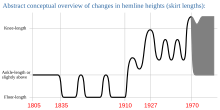Skirt hem theory
In 1926, George W. Taylor , an American economist from the Wharton School , published his skirt hem theory , according to which periods of economic boom cause the average length of skirts and costumes worn by women to decrease and vice versa. In the English-language secondary literature, the term hemline index is used as a synonym for the theory presented by Taylor. Individual observations indicate that Taylor's hemline index applies. British zoologist and science writer Desmond Morris referred to the hemline barometer in his book The Naked Monkey . An empirical study for the period from 1921 to 2009 comes to the conclusion that this theory is correct, but that skirt length reacts to macroeconomic developments with a delay of up to three years. Taylor is best known in the USA as the founder of arbitration in industrial disputes.
Microeconomic sentiment indices
The hemline barometer is not a recognized economic indicator in the professional world that allows reliable statements to be made about the economic situation. There is a general mood in the population, which is reflected in the length of the skirt hem and can have an impact on indicators of consumer sentiment. In this respect, the hemline barometer can be interpreted as a microeconomic indicator for the mood of consumers. In addition to fashion, such indicators also include popular art and economic reporting by the media, as well as the length of hair and others. Consumer sentiments, which are included in the consumer climate index (GfK) as psychological phenomena, for example, or which influence consumer confidence, play a role in the economy that should not be underestimated.
Validity of the skirt hem theory
According to Taylor's hypothesis, there is a direct relationship between the length of the skirt hem and the New York stock index. The special thing about this hypothesis is that it postulates a correlation between two very different spheres by relating the socially determined fashion to a predominantly economically determined stock index . Taylor concluded that prosperity is followed by optimism and risk-taking .
Due to the advanced customization and variety of fashion styles, the opinion is that this assumption is no longer true today.
The monthly French fashion magazine L'Officiel publishes data on the length of the skirt hem regularly and has archived its digitized editions online since 1921. In an empirical study, the information found there about the respective skirt length was divided into five categories:
- Mini,
- Ballerina (hem of the skirt ends above the knee joint),
- The hem of the skirt ends below the knee,
- Skirt reaches to the ankle or
- to the ground.
The data grouped in this way has been related to data on US business cycles collected by the National Bureau of Economic Research (NBER). The analysis of this data, carried out with the help of statistics , comes to the conclusion that skirt length reacts to macroeconomic developments in the manner postulated by George Taylor. However, this happens with a time lag of up to three years. This means that the skirt hem theory provides a lagging indicator, such as the growth in gross domestic product for one year.
literature
- Desmond Morris : The Naked Monkey . 26th edition. Droemer Knaur Verlag, Munich / Zurich 1995, ISBN 3-540-77936-1 .
Individual evidence
- ↑ Anders Mellbratt, Nils Wiberg: The Fallacy of Eco-Friendly Design. How progressive design can save it. (PDF) p. 1662, accessed on August 14, 2015 (English).
- ↑ Tamar Lewin: A Hemline Index, Updated - How Does Society Change in a Bad Economy? In: The New York Times . October 18, 2008, ISSN 0362-4331 ( nytimes.com [accessed August 15, 2015]).
- ↑ Hemline Theory: The long and short of it. In: plascontrends.co.za. Retrieved August 14, 2015 .
- ↑ Claire Brayford: The hemline Economy. Retrieved August 14, 2015 .
- ↑ a b The hemline and the Economy. In: repub.eur.nl. Retrieved August 14, 2015 .
- ^ Edward B. Shils: George W. Taylor: Industrial Peacemaker. (PDF) In: Monthly Labor Review. Retrieved August 16, 2015 (English, December 295, issue 29).
- ↑ John Magee: With Charts to Success: Applied Chart Analysis for Beginners and Advanced Users . 2nd Edition. FinanzBook Verlag, Munich 2006, ISBN 3-932114-47-7 , p. 149 ( google.de ).
- ↑ Sophie Woersdorfer: How the economic reporting of the media steers consumer confidence. (PDF) In: Wirtschaft im Wandel. 2005, accessed August 15, 2015 .
- ↑ Do shorter hair styles signify economic growth? (No longer available online.) In: fashion.telegraph.co.uk. Archived from the original on March 11, 2015 ; accessed on August 15, 2015 . Info: The archive link was inserted automatically and has not yet been checked. Please check the original and archive link according to the instructions and then remove this notice.
- ↑ Nancy Tengler: January Barometer? Check out these quirky market indicators. In: azcentral. The Arizona Republic. January 13, 2015, accessed August 15, 2015 .
- ↑ Joachim Benner, Carsten-Patrick Meyer: What do sentiment indicators do for forecasting real gross domestic product in Germany? (PDF) In: Die Weltwirtschaft. 2005, accessed August 15, 2015 .
- ↑ Kathryn Harrison: Lisa Appignanesi's 'Mad, Bad and Sad'. In: The New York Times. Retrieved August 15, 2015 .
- ↑ hemlines and the economy. Retrieved August 15, 2015 .
- ↑ Jalou Gallery. In: Les archives de l'officiel de la mode. Retrieved August 15, 2015 .
- ^ NBER US Business Cycle. In: nber.org. Retrieved August 15, 2015 .
